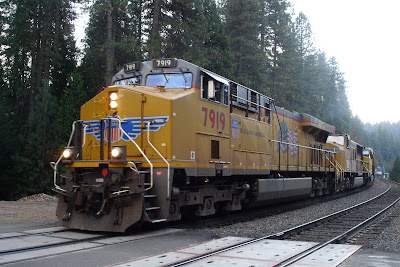

Southern Pacific had a problem at first. Then, when SP was bought out (actually owned by DRGW's Philip Anschutz) by Union Pacific on, oddly enough, 09-11-1996, Union Pacific inherited that problem.
And that is this:
Double-stack (also called intermodal) trains could not be run up and over Donner Pass due to tunnel clearance problems.
Now, double stack traffic can run over Donner.
If UP wanted to move double-stack traffic west/east, east/west through California, it had to do so through the Feather River Canyon -- once the province of the Western Pacific (purchased by UP on 12-22-1981).
The problem with the Feather River Canyon route is that it's inherently fluctuous. The Feather River is prone to flooding, and the area is rife with shale rock -- making the route notoriously unstable and -- as UP discovered once purchased -- requiring thousands and thousands of dollars spent for track stabilization programs to shore up the sides of mountains, hills, tunnels, sidings, bridges, trestles and basic trackwork.
The additional problem was that running double stack traffic east/west through the Feather River Canyon added 75 miles to the journey and another three hours.
Today, what is known as "Donner Pass" corresponds to Union Pacific's Roseville Subdivision, what are now termed the Number One and Number Two tracks from Roseville, California to Sparks, Nevada.
When originally holed in the mid-1800s by the Central Pacific, the tunnels comprising the Central Pacific portion of the Transcontinental Railroad were built only to accommodate the traffic of the day. And certainly not traffic corresponding to the height of today's double-stack well cars.
The average locomotive is 15 to 16 feet tall.
Auto rack cars are currently 20' 2" tall.
Double stack traffic can run up to 22-feet.
The specific tunnels in question were holed down to accomodate 22-foot traffic. Enviro- and historically-concerned issues included destruction of the original Chinese tunnels. But, as Union Pacific worked, it didn't scrape the tunnels up. Instead, it lowered the track beds through the affected portals.
Efficiency and history can be reconciled.
MP154




No comments:
Post a Comment